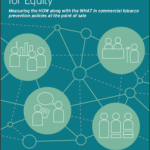This July will mark the one-year anniversary of ChangeLab Solutions’ release of the Policy Process Evaluation for Equity guide and web tool. It’s been a busy year! We want to lift up these resources by sharing what we have been hearing in conversations with practitioners who have used them. Read on to learn how this collection of research and menus has been striking our partners — and us — in practice.
Across the policy process — from assessments to policy development, passage, implementation, and evaluation — folks are always looking for ways to better account for their foundational investments in community relationships. While we all experience how relationships are essential to improving the outcomes and sustainability of our policies, it is harder to see, measure, and rally for more incremental benefits along the way, such as increased civic engagement, personal agency, community connectedness, and trust.
Our partners wanted evidence-based ways to measure those hard-to-quantify aspects of intentional community engagement in their policymaking efforts, to communicate not only the return on investment for their partnership efforts but also the value of their “secret sauce” (as one public health practitioner described it) — that is, the respect, trust, and authenticity that are the foundation of real community change. After a year of interacting with partners new and old following the release of our policy process evaluation resources, we are grounded and motivated by what we’ve heard. The research included in the guide and web tool confirms what feels intuitive to many: deep partnerships and power sharing alter the policy process in ways we cannot expect, influencing the effectiveness and sustainability of any resulting policy. As one partner from New York State reflected, “[The tool] explores what we were asking ourselves: how to measure transformational tactics versus transactional ones?”
And how thrilling it is to hear stories about how these types of collaborations tend to expand into other policy areas! For example, in one southern community, what began as an effort to share power with those receiving medical care and tobacco cessation services expanded to encompass young people’s health and well-being more broadly. It eventually grew into a wraparound network of social service connections, workforce training, and small business supports. And this type of exciting expansion is in addition to how these deeper partnerships can directly influence the health of those involved — those whose lives are most affected by the issues. The relationships also support and sustain those who help implement, enforce, and improve community policies.
Another example involves practitioners across a range of rural communities that are developing tobacco prevention partnerships with explicit attention on equitable implementation and enforcement considerations. Even in the planning and development phase, this group of practitioners is working to enrich their collaborations with community partners by grounding the planning process in a systems mindset: recognizing that any resulting policies will join the larger system of interactions between local governments and their residents.
As we look back on the conversations and technical assistance that fed into the guide, as well as the conversations spurred since its release, we are inspired by the self-reflection and commitment that public health practitioners all over the country share when they talk about their efforts to respect and center their relationships with community members. We hope that these resources honor some aspects of public health work that often go unseen and unmeasured yet are essential. And we’re listening! Please share your own examples of community-centered evaluation that captures how the policy process itself can be a tool to improve health equity!
6/12/2024

